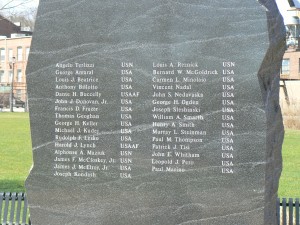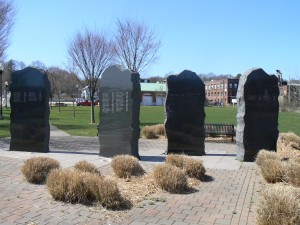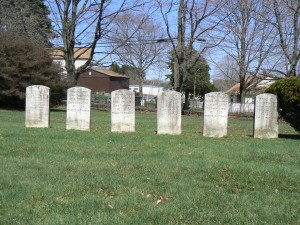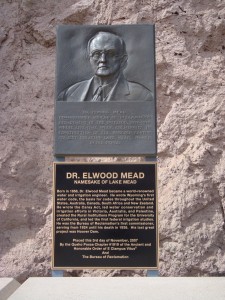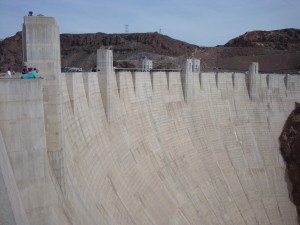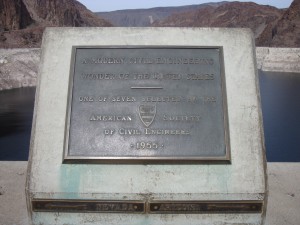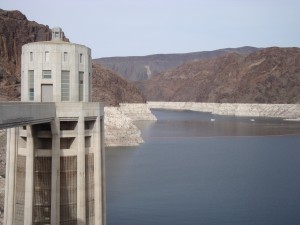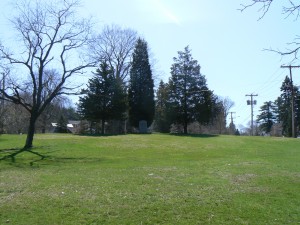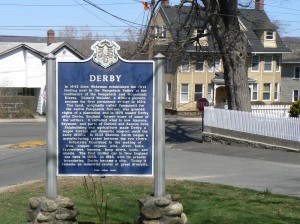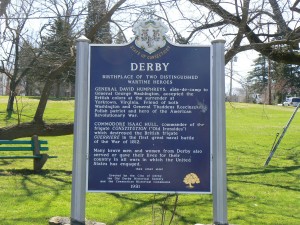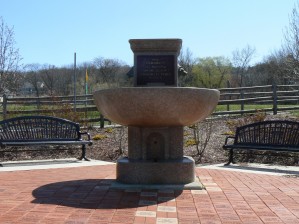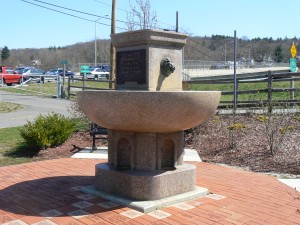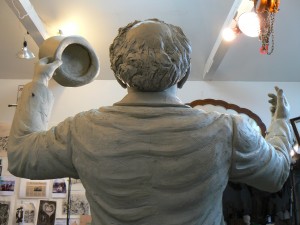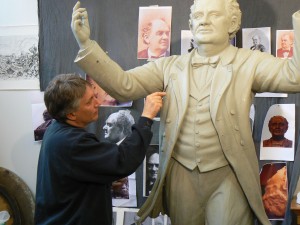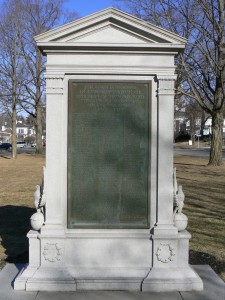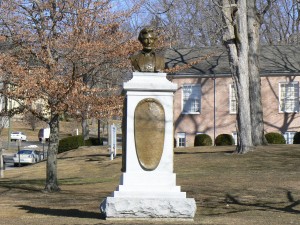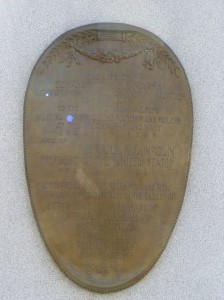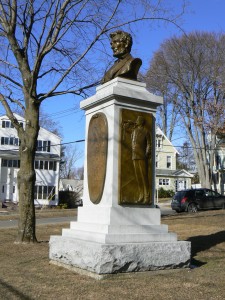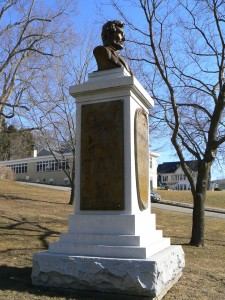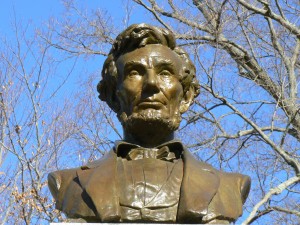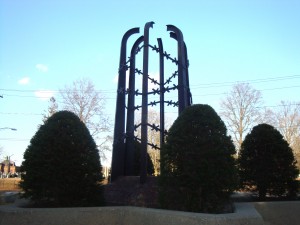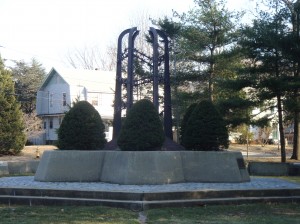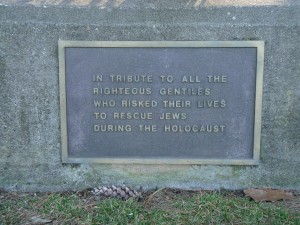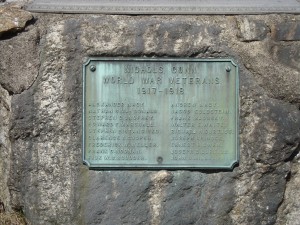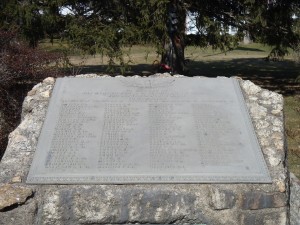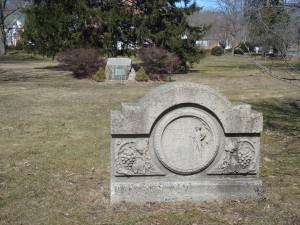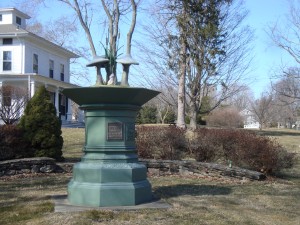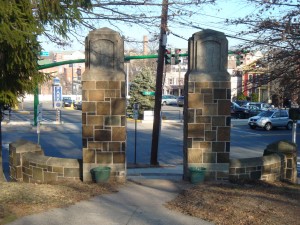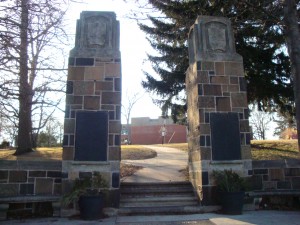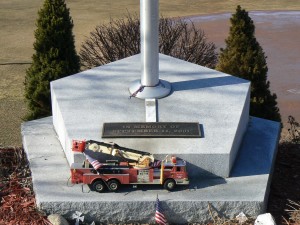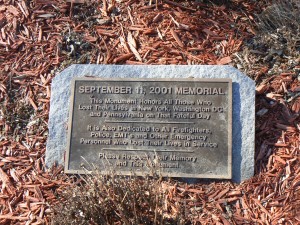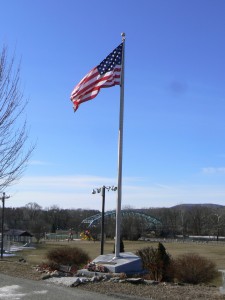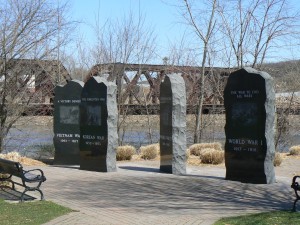 Shelton veterans killed in the 20th Century’s four major wars are honored with large granite monuments near the downtown riverfront walkway.
Shelton veterans killed in the 20th Century’s four major wars are honored with large granite monuments near the downtown riverfront walkway.
The site honors veterans with four large polished-granite slabs commemorating Vietnam, Korea, World War II and World War I. Each slab bears a brief dedication to the war as well as an historic image on its front (west) face, and the names residents who were killed in the conflict are engraved on the monument’s east face.
The Vietnam memorial bears the dedication “A Victory Denied,” and right names. The Korean war memorial reads “The Forgotten War,” and bears three names.
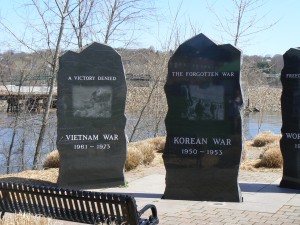 The World War II memorial reads “Freedom is Not Free,” and bears 31 names. (The east face of the World War II memorial is pictured below). The World War I slab bears the dedication, “The War to End All Ears,” and 17 names.
The World War II memorial reads “Freedom is Not Free,” and bears 31 names. (The east face of the World War II memorial is pictured below). The World War I slab bears the dedication, “The War to End All Ears,” and 17 names.
Six Shelton residents who were killed in overseas conflicts are also honored in the city’s Riverside Cemetery, about about 1.5 miles south of the downtown memorial. Five headstones honor World War I heroes who were buried in France, and another headstone honors a Korean War hero buried in that country.
Nearby monuments honor the service of local firemen and police officers.
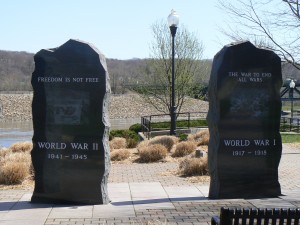 Shelton also honors its war heroes with a building in nearby Riverview Park, as well as with monuments in front of City Hall and the Plumb Memorial Library. Those monuments will be highlighted in future posts.
Shelton also honors its war heroes with a building in nearby Riverview Park, as well as with monuments in front of City Hall and the Plumb Memorial Library. Those monuments will be highlighted in future posts.
A municipal committee is also planning to erect a Civil War monument. During the Civil War, Shelton was known as Huntington, and its veterans were honored on the Civil War monument on the Derby Green.
Tags: Shelton
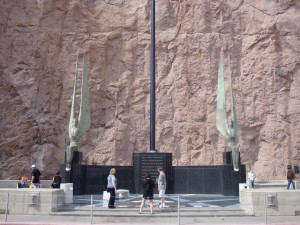 Monuments on the Nevada side of Hoover Dam honor the dam’s designers and builders, as well as the estimated 96 workers who died during its construction.
Monuments on the Nevada side of Hoover Dam honor the dam’s designers and builders, as well as the estimated 96 workers who died during its construction.
The largest sculpture at the dam site is the dedication monument, which stands near the visitors’ center on the dam’s Nevada (northwest) side. The monument, by Norwegian-American sculptor Oskar J.W. Hansen, depicts two winged allegorical figures sitting alongside a polished black diorite base.
The base of the monument, which also holds a large flagpole, bears a dedication reading, “It is fitting that the flag of our country should fly here in honor of those men who, inspired by a vision of lonely lands made fruitful, conceived this great work, and of those others whose genius and labor made that vision a reality.”
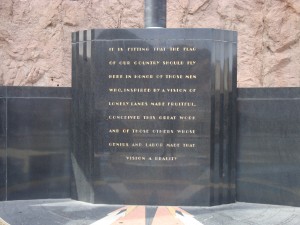 The 30-foot high bronze figures represent the combination of physical and intellectual strength used to create the dam, an engineering feat the sculptor compared with the construction of Egypt’s pyramids.
The 30-foot high bronze figures represent the combination of physical and intellectual strength used to create the dam, an engineering feat the sculptor compared with the construction of Egypt’s pyramids.
The plaza surrounding the monument bears the seals of the seven states that receive water or electricity from the Hoover Dam project, as well as an astronomical mosaic depicting the heavens on the dam’s dedication date of September 30, 1935.
Near the flagpole are two monuments honoring men who died during its construction. One, also by Hansen, features a muscular figure rising from a river. A dedication reads, “They died to make the desert bloom.”
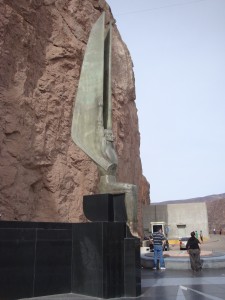 The monument has two dedication plaques. On the left (as you face the monument) a plaque reads, “The United States of America will continue to remember that many who toiled here found their final rest while engaged in the building of this dam.”
The monument has two dedication plaques. On the left (as you face the monument) a plaque reads, “The United States of America will continue to remember that many who toiled here found their final rest while engaged in the building of this dam.”
On the right, another plaque reads, “The United States of America will continue to remember the services of all who labored to clothe with substance the plans of those who first visioned the building of this dam.”
To the immediate right of this monument, the Boulder City Central Labor Council erected a plaque to honor laborers who died during the construction.
The number of workers killed during construction is officially recorded at 96, but the actual number may have been higher since contractors are believed to have reported carbon monoxide poisoning, a common hazard on the site, as pneumonia.
To the right of the Boulder City monument, two plaques honors Elwood Mead, who served as commissioner of the Bureau of Reclamation during the design and construction of 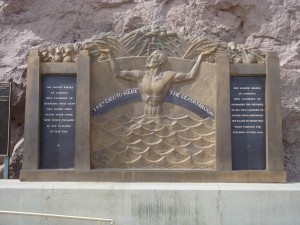 Hoover Dam. Lake Mead, which was formed by the dam, was named in his honor. An undated plaque appears to be from the mid-1930s, and a later plaque with additional information about Mead’s work was dedicated in 2007.
Hoover Dam. Lake Mead, which was formed by the dam, was named in his honor. An undated plaque appears to be from the mid-1930s, and a later plaque with additional information about Mead’s work was dedicated in 2007.
Hoover Dam
Hoover Dam was built between 1931 and 1935 to prevent flooding of farmlands near the Colorado River, to provide controlled irrigation to several states in the Southwest, and to power a hydroelectric plant that would serve Nevada, Arizona and California. Hoover Dam, the largest in the world at the time of its construction, is today regarded as an outstanding engineering feat and the dam remains a popular tourist location.
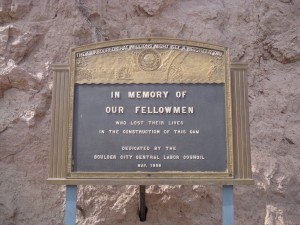 Hoover Dam, in the Colorado River’s Black Canyon, was originally planned to be constructed in the nearby Boulder Canyon before engineers decided Black Canyon offered a better choice. The dam was named after president Herbert Hoover, who lost the 1932 election to Franklin Delano Roosevelt. Roosevelt’s Secretary of the Interior, Harold Ickes, advocated removing Hoover’s name from the dam, and plaques on a building atop the dam refer to it as the “Boulder Canyon Project.” Hoover’s name was returned to the dam in 1947.
Hoover Dam, in the Colorado River’s Black Canyon, was originally planned to be constructed in the nearby Boulder Canyon before engineers decided Black Canyon offered a better choice. The dam was named after president Herbert Hoover, who lost the 1932 election to Franklin Delano Roosevelt. Roosevelt’s Secretary of the Interior, Harold Ickes, advocated removing Hoover’s name from the dam, and plaques on a building atop the dam refer to it as the “Boulder Canyon Project.” Hoover’s name was returned to the dam in 1947.
A large bridge is being built across the canyon to improve traffic flow along Highway 93. The two-lane roadway across the dam and security checkpoints as driver approach the dam have led to bottlenecks that the bridge is designed to help relieve.
 Sources: Bureau of Reclamation, Department of the Interior
Sources: Bureau of Reclamation, Department of the Interior
Wikipedia: Hoover Dam
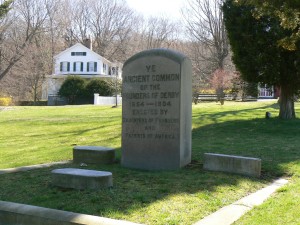 A monument dedicated in 1904 marks the first green in the city of Derby.
A monument dedicated in 1904 marks the first green in the city of Derby.
Founders Common, as the green is known, is flanked by Academy Hill Road and Clark Avenue in East Derby.
The granite monument’s front (north) face bears a dedication reading “Ye ancient common of the founders of Derby, 1654-1904. Erected by Daughters of Founders and Patriots of America.”
The monument stands between two evergreen trees and is surrounded by three ankle-height oval markers, the significance of which was not readily apparent. The site is surrounded by a low granite fence.
At the northern tip of the green, near where Academy Hill Road and Clark Avenue meet, stands an historical marker erected in 1981. The southern side of the marker describes the settling of Derby in 1654 as well as the city’s manufacturing heritage. The marker’s north side honors American Revolution heroes General David Humpreys and Commodore Isaac Hull.
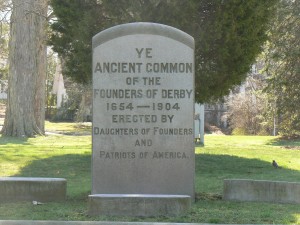 Founders Common, which slopes rather sharply from south to north, was the site of Derby’s first green and its original schoolhouse. Today’s Derby Green, in the city’s downtown section, was laid out in 1839 when the industrial section originally known as Birmingham was developed.
Founders Common, which slopes rather sharply from south to north, was the site of Derby’s first green and its original schoolhouse. Today’s Derby Green, in the city’s downtown section, was laid out in 1839 when the industrial section originally known as Birmingham was developed.
A fountain that stood on Founders Common until its 2007 restoration is now located about a quarter-mile to the west, at the northern end of the Derby Greenway. The fountain, which was donated to Derby in 1906 by the National Humane Alliance, originally stood in the intersection of Seymour Avenue and Atwater Avenue. The fountain was moved to Founders Common after increased traffic levels and the construction of Route 8 made its location in the middle of the roadway unsafe.
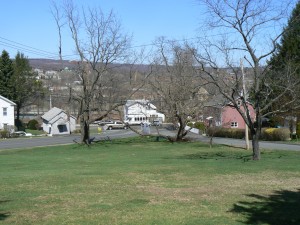 The lion head spigots decorating three sides of the fountain were recreated during the 2007 restoration. The National Humane Alliance, which was dedicated to protecting horses and other work animals, donated about 125 fountains to cities nationwide.
The lion head spigots decorating three sides of the fountain were recreated during the 2007 restoration. The National Humane Alliance, which was dedicated to protecting horses and other work animals, donated about 125 fountains to cities nationwide.
The fountain is part of a plaza with numerous dedication bricks.
Source: The Electronic Valley
Tags: Derby
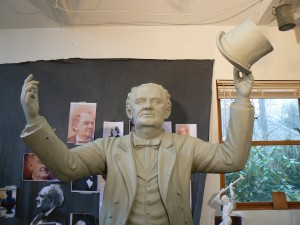 The Bethel Historical Society and sculptor David Gesualdi are celebrating the 200th anniversary of P.T. Barnum’s birth year with a new statue that will be dedicated in September.
The Bethel Historical Society and sculptor David Gesualdi are celebrating the 200th anniversary of P.T. Barnum’s birth year with a new statue that will be dedicated in September.
Dave Gesualdi, who was also responsible for Bethel’s Veterans’ Monument, estimates he has four to five weeks’ worth of work before the 600-pound clay sculpture that dominates his Bethel studio is sent to the foundry.
The statue, scheduled to be dedicated on Sept. 25 as part of a celebration of Barnum’s life that will include a parade, depicts the noted showman, political and social leader waving a top hat and striding forward.
“I have to age him and add a lot of the character details like his eyeballs, but most of the structure is in place,” Dave says.
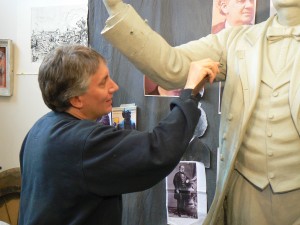 After being approached by the Historical Society early last year, Dave began sketching preliminary designs for the statue. Three models were displayed in the local library, and residents voted on the winning design.
After being approached by the Historical Society early last year, Dave began sketching preliminary designs for the statue. Three models were displayed in the local library, and residents voted on the winning design.
“I really liked the symbolism of Barnum throwing his hat into the ring,” Dave says. “You always see a lot of photos of Barnum with the hat, so we decided early on to include that in the theme. I also felt strongly that I wanted to have him taking a step forward into the world. Barnum was a vibrant man of action, and I couldn’t conceive of portraying him seated.”
The top hat, while being historically accurate, also pays tribute to Bethel’s former role as a hat manufacturing center.
To capture Barnum’s appearance, the walls of Dave’s studio are decorated with contemporary photos. He also studied the 1893 Barnum monument in Bridgeport’s Seaside Park, which the showman posed for in his later years. Highlights of that visit can be seen in a YouTube video.
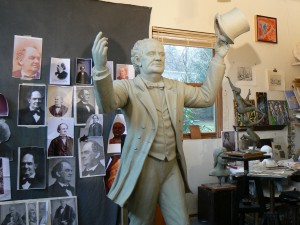 The Barnum statue will be cast at the Polich Tallix Fine Art Foundry in Rock Tavern, N.Y., using the lost-wax casting method. Under this process, the clay statue will be coated with rubber to create a mold. The rubber mold will be used to form a wax version of the statue that will be dipped several times in a ceramic mixture, and that mixture will be hardened to create another mold. The ceramic mold will be filled with the molten bronze that will yield the final statue.
The Barnum statue will be cast at the Polich Tallix Fine Art Foundry in Rock Tavern, N.Y., using the lost-wax casting method. Under this process, the clay statue will be coated with rubber to create a mold. The rubber mold will be used to form a wax version of the statue that will be dipped several times in a ceramic mixture, and that mixture will be hardened to create another mold. The ceramic mold will be filled with the molten bronze that will yield the final statue.
“I’ll be working on the final details with the wax version, and smoothing things out with sharp tools and hot tools,” Dave says.
A number of the statue’s design considerations are based on its being displayed outdoors. For instance, the depth of the interior of Barnum’s top hat is being limited to prevent birds or bees from nesting inside, and Dave tried to reduce places where rainwater could collect on the statue.
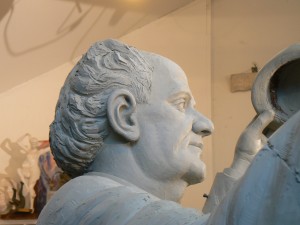 Similarly, elements such as Barnum’s collar and bow tie were made thicker than life-size so they’ll stand out to a viewer looking up at the statue, which will be mounted on a four-foot base.
Similarly, elements such as Barnum’s collar and bow tie were made thicker than life-size so they’ll stand out to a viewer looking up at the statue, which will be mounted on a four-foot base.
Independent filmmaker Corey Boutilier is documenting the creation of the Barnum statue and Barnum’s life in a film, P.T. Barnum The Lost Legend, scheduled for release in November.
The statue’s progress is also being chronicled on a Facebook page available at http://www.facebook.com/ptbarnum.
Tags: Bethel
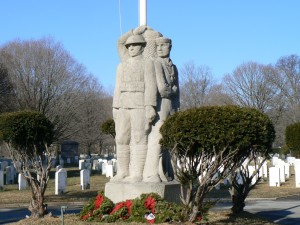 The Darien police and a local VFW post are raising money to restore the 1936 memorial flagpole honoring veterans in Spring Grove Cemetery.
The Darien police and a local VFW post are raising money to restore the 1936 memorial flagpole honoring veterans in Spring Grove Cemetery.
The memorial flagpole, which we visited a little over a year ago, was designed by sculptor Karl Lang, who was also responsible for the Timothy Ahern memorial statue in New Haven.
According to coverage in the Darien Times, the groups hope to replace the plants in the traffic circle surrounding the flagpole’s base. The base has figures symbolizing veterans of the Civil War, the Spanish-American War and World War I, and organizers hope to replace the plantings by Memorial Day.
Spring Grove Cemetery served as Connecticut’s veterans’ cemetery when the state’s first veteran’s home, the Fitch Home for Veterans and Their Orphans, operated in Darien. The Fitch facility served veterans between 1864 and 1940, when the state veterans’ home moved to Rocky Hill.
Spring Grove is the final resting place for 2,184 veterans.
The Darien VFW post can be contacted at http://www.darienvfw.org/
Tags: Darien
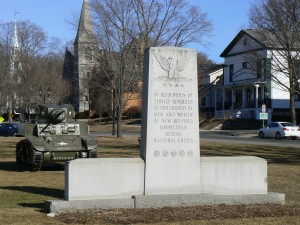 New Milford honors local veterans and war heroes with a collection of monuments along the town green.
New Milford honors local veterans and war heroes with a collection of monuments along the town green.
At the southern end of the New Milford green, a large monument honors all local veterans. The monument features a large carved eagle, and an inscription on its southern face reads, “In recognition of service rendered to our country by [the] men and women of New Milford, Connecticut, during national crises.” Below the inscription are the shields of the five military branches.
Just above this monument (if you’re moving north along the green) is a restored World War II tank that, according to the New Milford Historical Society, was placed on the green in 1948 by the local VFW post.
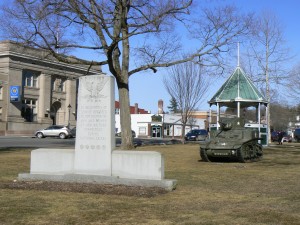 To the east of these memorials, a flagpole honors New Milford’s World War II veterans. A plaque on the flagpole’s stone base lists 18 residents who list their lives.
To the east of these memorials, a flagpole honors New Milford’s World War II veterans. A plaque on the flagpole’s stone base lists 18 residents who list their lives.
Continuing north, we find a granite monument that honors World War I veterans on its southern face and Civil War veterans on its northern side. The World War I plaque bears the dedication, “This tablet is dedicated in commemoration of the men of New Milford who served their country in the World War.” Below the dedication are three columns of names, including 12 who were killed in the conflict.
The Civil War plaque on the monument’s northern face bears a nearly identical inscription that also appears above three columns of names. Two granite eagles that flank the east and west sides of the monument’s base have lost their beaks over the years.
 North of the World War I/Civil War monument is the bell of the USS Pittsburgh, the flagship of Harry Shepard Knapp. Knapp, who had extensive family ties to New Milford, was a World War I vice admiral of the U.S. Navy, military governor of Santo Domingo, and the U.S. military representative in Haiti. The monument with the bell was dedicated in 1951.
North of the World War I/Civil War monument is the bell of the USS Pittsburgh, the flagship of Harry Shepard Knapp. Knapp, who had extensive family ties to New Milford, was a World War I vice admiral of the U.S. Navy, military governor of Santo Domingo, and the U.S. military representative in Haiti. The monument with the bell was dedicated in 1951.
Just above the northern end of the green, a monument honors Abraham Lincoln with a bronze bust. The front (south) side of the monument’s base features an elongated oval plaque (not unlike a pressed penny) inscribed with the Gettysburg Address. The north side features a similar plaque explaining the monument is a 1912 gift of Edward Williams Marsh, who served in Company M of the Second Connecticut Volunteers Heavy Artillery regiment during the war.
The monument is dedicated, “In Loving Memory of the Soldiers and Sailors of the Union Army and Navy, 1861-1865, and of Abraham Lincoln,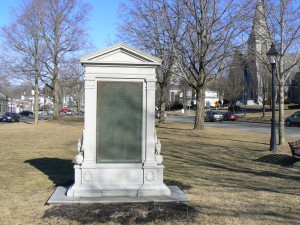 President of the United States, 1861-1865. Besides being in many skirmishes, the New Milford troops were engaged in the battles of Gettysburg, Cold Harbor (Va.), Petersburg (Va.), Opequan (Va.), Fisher’s Hill (Va.), Cedar Creek (Va.), Sailors Creek (Va)., Fort Fisher (N.C.)”
President of the United States, 1861-1865. Besides being in many skirmishes, the New Milford troops were engaged in the battles of Gettysburg, Cold Harbor (Va.), Petersburg (Va.), Opequan (Va.), Fisher’s Hill (Va.), Cedar Creek (Va.), Sailors Creek (Va)., Fort Fisher (N.C.)”
Tags: New Milford
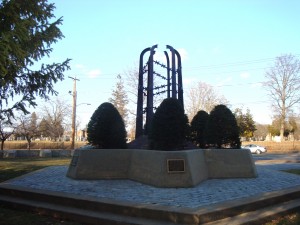 New Haven honors victims of the Holocaust with a monument in the city’s Edgewood Park.
New Haven honors victims of the Holocaust with a monument in the city’s Edgewood Park.
The monument, at the corner of Whalley Avenue and West Park Avenue, was the country’s first Holocaust Memorial built on public land when it was dedicated in 1977.
The monument features a large sculpture with a Star of David base. Six curved bars wrapped in barbed wire symbolize Nazi concentration camps, and small trees in the monument’s base honor the six million Jewish Holocaust victims.
A plaque on the northeast side of the monument’s base reads, “We remember the six million Jews murdered by the Nazis during World War II 1939-1945 (5699-5705). Dedicated by the city of New Haven [and the] New Haven Jewish Federation.”
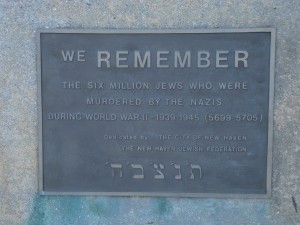 A nearby plaque in Hebrew bears what we assume to be a similar dedication. Plaques on the rear wall of the plaza bear dedications to all of the innocent Holocaust victims as well as the Gentiles who helped rescue Jews during the Holocaust.
A nearby plaque in Hebrew bears what we assume to be a similar dedication. Plaques on the rear wall of the plaza bear dedications to all of the innocent Holocaust victims as well as the Gentiles who helped rescue Jews during the Holocaust.
The memorial, designed by architect Augustus J. Franzoni, stands in the center of a grassy plaza. The exterior wall features a number of granite plaques bearing the names of local families. A box containing dirt and ashes from Auschwitz was interred at the site during groundbreaking ceremonies.
The monument is the site of an annual Holocaust commemoration.
Source: Jewish Historical Society of Greater New Haven
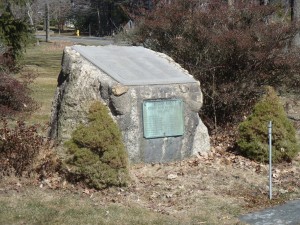 A boulder on the village green in the Nichols section of Trumbull honors veterans of both World Wars.
A boulder on the village green in the Nichols section of Trumbull honors veterans of both World Wars.
The boulder, not far from the green’s southwest tip and the intersection of Shelton Road and Huntington Turnpike (Route 108), features two undated plaques honoring local veterans.
The World War I plaque, mounted on the front face of the monument, lists the names of 18 residents under the heading “Nichols, Conn., World War veterans, 1917-1918.
Atop the boulder, a plaque honors World War II veterans with a dedication reading, “In memory of the men and women of the Village of Nichols who served in World War II.” The plaque also lists the names of five residents who were killed, and the names of 103 residents are listed in four columns.
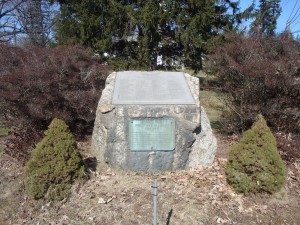 Also near the tip of the green, a stone monument bears the seal of the town of Trumbull.
Also near the tip of the green, a stone monument bears the seal of the town of Trumbull.
To the west of the green, near the corner of Huntington Turnpike and Unity Road, stands the village’s landmark Bunny Fountain. The fountain originally stood at the tip of the green, and included a kerosene lamp and a horse trough. Over the years, the lamp was removed and the bunnies were added, and the fountain was moved twice to its present location.
 A memorial gateway in the Westville section of New Haven honors local residents who served in the Civil War.
A memorial gateway in the Westville section of New Haven honors local residents who served in the Civil War.
The 1915 monument, at the entrance to the city’s Beecher Park, stands at the corner of Whalley Avenue and Philip Street. Two plaques on the front (northeast) face of the monument bear a dedication reading, “Erected by the Westville Soldiers Memorial Association to commemorate those who enlisted from this place in the War of 1861-1865.”
The plaque on the left pillar (as you face the monument) lists 32 names, and the plaque on the right pillar lists 33 names. The left column also bears the seal of the United States, and the right column bears the Connecticut seal.
Benches extend from the monument’s pillars, and bronze letters embedded in the walkway between the columns read, “Soldiers’ Memorial A.D. 1915.”
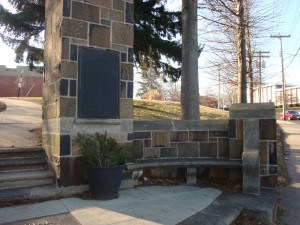 The monument was constructed from local traprock, most likely from the West Rock formation that stands just west of the park. The gateway was designed by architect Ferdinand Von Beren, who was also responsible for a number of downtown buildings and New Haven schools.
The monument was constructed from local traprock, most likely from the West Rock formation that stands just west of the park. The gateway was designed by architect Ferdinand Von Beren, who was also responsible for a number of downtown buildings and New Haven schools.
Tags: New Haven
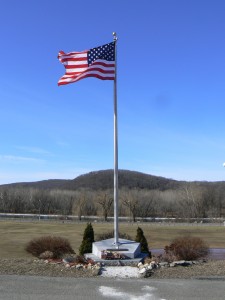 New Milford honors the victims of the Sept. 11, 2001, terrorist attacks with a memorial overlooking a park and the Housatonic River.
New Milford honors the victims of the Sept. 11, 2001, terrorist attacks with a memorial overlooking a park and the Housatonic River.
The memorial features a flagpole with a pentagon-shaped base with a plaque reading, “In memory of September 11, 2001.”
Next to the flagpole, a plaque mounted on a small granite base reads, “This monument honors all those who lost their lives in New York, Washington, D.C., and Pennsylvania on that fateful day. It is also dedicated to all firefighters, police, EMTs, and other emergency personnel who lost their lives in service. Please respect their memory and this monument.”
The area surrounding the monument has also been decorated with a number of personal effects.
Immediately west of the monument, visitors can see Young’s Field, a New Milford recreational park, and the Housatonic River. The large hill in the background is Fort Hill, the site of a former Native American village.
Tags: New Milford
